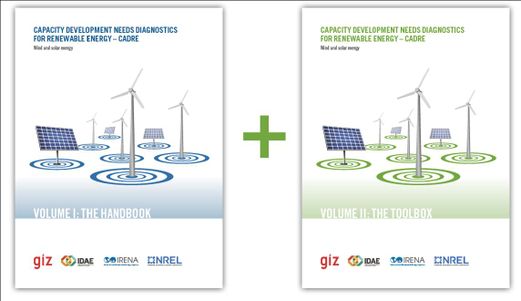Capacity Needs Diagnostics for Renewable Energies (CaDRE)
Capacity Development Needs Diagnostics for Renewable Energy (CaDRE) is the first phase of a process to support the development of capacities on the individual, organizational and system level of a countries renewable energy sector.
The purpose of the CaDRE is to provide governments with the process and tools necessary to undertake an analysis of the current capacity of their renewable energy industry and sector. By assessing of the existing and required capacities, CaDRE defines the “capacity gap” and the “capacity development needs” which need to be addressed to support the further deployment of renewable energy. It provides governments and stakeholder the required information for designing a demand oriented capacity development strategy and creates the basis for their implementation.
The CaDRE concept was cooperatively developed by the Deutsche Gesellschaft für Internationale Zusammenarbeit GmbH (GIZ), the Instituto para la Diversificación y Ahorro de la Energía (IDAE), the International Renewable Energy Agency and the US- National Renewable Energy Laboratory (NREL).
Conceptional background
The successful development of renewable energy is dependent on the existence of institutional and individual capacity to enable it. Capacity is required across all levels including the system level, the organisation level, and at the individual level. The system level requires capacity within its policy framework and business environment which will enable the deployment of renewable energy. To utilise this system level capacity requires organisations and institutions with the ability to effectively and efficiently fulfill their mandates with regard to renewable energy deployment. In turn this is built on the capacity of the available personnel that must possess the latest knowledge of the technical and managerial issues related to renewable energy. For the long term sustainability of the sector it is also important to consider the capacity of the current and future direct workforce, and the necessity of establishing networks and platforms for further industry development.
CaDRE Handbook and Toolbox for wind and solar energy
In order to support its implementation, GIZ, NREL, IDEA and IRENA jointly produced and published a practitioners Handbook and Toolbox for CaDRE. The Handbook and Toolbox provide a step-by-step guide to help practitioners plan and conduct comprehensive capacity needs diagnostics at a national, regional or local level.
The Handbook provides:
- A description of the requirements and necessary conditions for conducting a CaDRE.
- Concrete, practical and user-oriented guidelines on how to conduct comprehensiv capacity needs diagnostics (at the system, institutional, network and individual levels) and how to interpret and prioritise results to facilitate strategic decision making.
- A modular design that allows quick, partial or full diagnostics depending on the desired scope and focus, budget or time availability.
- An overview and sequence of recommended tasks to be completed throughout the diagnostic and decision making processes.
- Practical recommendations and references to useful and proven tools which facilitate the diagnostic process.
- Experiences and lessons learnt from previous capacity needs diagnostics and capacity development projects.
- Suggestions on how to integrate the results in the capacity development cycle.
The Toolbox complements the Handbook, providing a compendium of practical tools that support the diagnostic process.





















